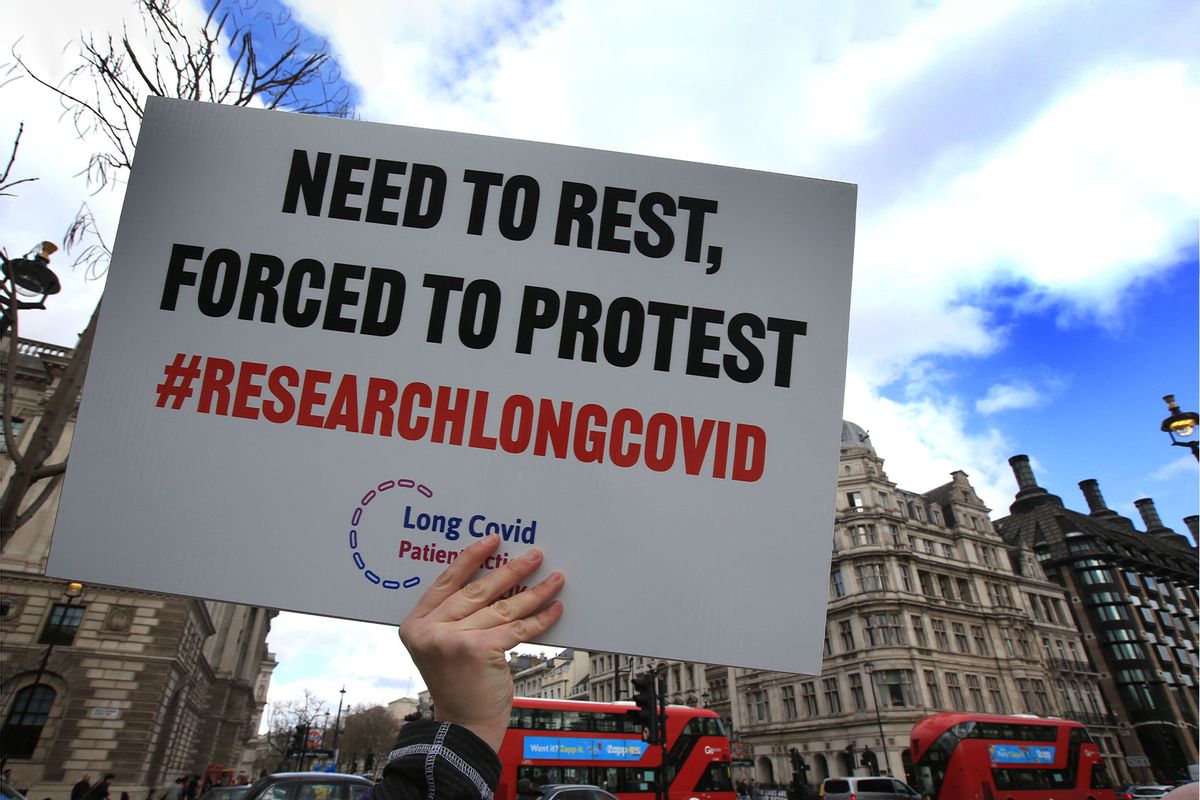Another report minimizes long COVID risk. Long haulers say the threat is being ignored

When Erica Hayes was infected with the SARS-CoV-2 virus in November 2020, her symptoms were mild and she didn’t even have a cough. It’s what followed that was worrisome: extreme weakness, such that she couldn’t even lift her arms up to fold laundry; a racing heart that felt like it would burst out of her chest just from cooking a meal; and her body forgetting to breathe on its own, leaving her gasping for breath.
Although her doctor reassured her she wasn’t having a heart attack, which presents with similar symptoms, she went to the emergency room to get checked out. They, too, told her these were just side effects of COVID-19 that would pass along with the infection. But days went by. Then weeks, and years.
“I have spent months where I’m very limited and even getting out of bed is unbelievably uncomfortable because of the light and sun sensitivity, and I can’t even think or talk at all,” Hayes told Salon in a phone interview. “You can’t move. It’s just like a living dead state.”
“You can’t move. It’s just like a living dead state.”
Hayes was diagnosed with long COVID, a condition in which the symptoms of COVID infection last for weeks or far longer, and over the course of nearly three years her condition continued to worsen. She was also diagnosed with a host of secondary conditions, including myalgic encephalomyelitis/chronic fatigue syndrome (ME/CFS), asthma, chronic sinusitis, a positional tremor and orthostatic hypotension, which causes sharp changes in blood pressure that make her faint.
A mother of two, Hayes needed a wheelchair to prevent her from hurting herself if she were to collapse in or outside her home. But her first physical therapist didn’t want to prescribe her one because they didn’t want her to become dependent on it, she said. Eventually, her cardiologist did write her a prescription for a motor scooter, but it couldn’t be delivered for six months and she ended up having to create a GoFundMe to get one sooner herself.
Hayes, a user experience designer who made websites before her condition put her out of work, is one of an estimated 18 million adults to be diagnosed with long COVID and one of an estimated half million people who have stopped working because of it. Many with long COVID have come together in grassroots patient advocacy groups because so many of them feel they have been forgotten and dismissed by the medical community. Without a cure or many effective treatments in sight, many are still adapting to a new life with what looks like could be lifelong disabilities.
“All of my conditions that I’ve been diagnosed with since having COVID are lifelong conditions,” Hayes said. “No one’s telling me I will regain a quality of life that would let me get back to work.”
Some in the long COVID space say it’s one of many recent attempts to minimize long COVID, which has been called the greatest mass-disabling event in human history.
Last month, an article published in the BMJ argued that the body of research used to estimate the prevalence of long COVID was flawed and exaggerated, suggesting a portion of those 18 million are not sick with the condition. But some in the long COVID space say it’s one of many recent attempts to minimize long COVID, which has been called the greatest mass-disabling event in human history. Many of those who do have long COVID, sometimes called long haulers, are all too familiar with having their condition erased and say there needs to be more research and resources dedicated to finding treatments for long COVID.
“It shouldn’t really matter if we’re 1% of the population or 5%,” Hayes said. “People are suffering. It’s a really ableistic point of view … When people talk about how [severe COVID-19] is only in the elderly or only people with pre-existing conditions, it’s hinting at placing value on human life.”
The symptoms for long COVID — a debilitating illness following a COVID-19 infection that can affect the brain, heart and lungs — vary from person to person, but may include extreme fatigue, headaches, nausea or even some symptoms that mirror those caused by neurodegenerative diseases. The Centers for Disease Control and Prevention estimate that between 7% of the U.S. population or one in five people who have had a SARS-CoV-2 infection develop long COVID.
It’s unclear what causes long COVID in some but not others, however recent research has highlighted that people with long COVID have lower levels of cortisol, which could explain the fatigue, and that dormant viruses in the body may be reactivated by COVID infection. Some studies also suggest that reservoirs of SARS-CoV-2 virus may also be lingering in long COVID patients.
“There was a purposeful decision to make the diagnostic criteria broad so that we did not leave anyone behind.”
It can take decades for medical researchers to understand a condition and come up with effective treatments. Dr. David Putrino, a long COVID researcher and professor of rehabilitation medicine at the Icahn School of Medicine at Mount Sinai, said he thinks it will be five to 10 years before the medical community can definitively say how many people had or have long COVID.
“The point is, we know it’s a nonzero and there are enough cases of long COVID in America and around the world that mean it doesn’t meet the criteria of a rare disease or illness,” Putrino told Salon in a phone interview. “We know that in nontrivial and nonsignificant cases, an acute COVID infection leads to a chronic disability that currently doesn’t have a cure.”
The authors of the BMJ study did not respond to Salon’s request for comment before publication of this story. In the paper, the authors state that overestimating long COVID could increase social anxiety and healthcare spending, while also diverting resources from those who do have long COVID or leaving untreated other conditions misdiagnosed as long COVID. One of the authors, Dr. Vinay Prasad, has frequently posted controversial pandemic messaging and has been accused of disseminating misinformation through blog posts with titles like, “Do not report COVID cases to schools & do not test yourself if you feel ill.”
“Inappropriate definitions and flawed methods do not serve those whom medicine seeks to help,” the study authors wrote. “Improving standards of evidence generation is the ideal method to take long COVID seriously, improve outcomes, and avoid the risks of misdiagnosis and inappropriate treatment.”
Yet the decision to cast a wide net when constructing diagnostic criteria for long COVID was intentional because COVID and long COVID are so new — and there were, and still are, so many unknowns surrounding these novel diseases, Putrino said.
Want more health and science stories in your inbox? Subscribe to Salon’s weekly newsletter Lab Notes.
“There was a purposeful decision to make the diagnostic criteria broad so that we did not leave anyone behind,” Putrino said. “If we hadn’t made the clinical case definition broad, individuals who have lapsing remitting symptoms — so they can work on the good weeks, five days a week, but on their bad weeks, they can only work one day a week — they would be left behind.”
A comprehensive long COVID review paper published in Nature Reviews Microbiology last January also suggests some long COVID studies were flawed but concludes instead that this likely underestimates the number of people with long COVID. Because PCR tests have a high false negative rate and COVID-19 was thought to only affect the respiratory system at first, some long COVID patients may have been missed, according to the study. Overall, long COVID commonly presents with any number of about 10 symptoms, but over 200 different symptoms have been traced back to the illness.
Further complicating estimates of how many people have long COVID is that vaccinations and natural immunity have over time reduced the number of people getting new SARS-CoV-2 infections.
“We should understand that these fluctuations in case counts have occurred because of the changes that have occurred to the virus, the changes that have occurred to our bodies and the changes that have occurred to our ability to mitigate and treat some of the pathobiology of COVID-19,” Putrino said. “But this idea that we were trying to erase long COVID so that we can get back to work does not align with the science.”
“This idea that we were trying to erase long COVID so that we can get back to work does not align with the science.”
Neurological conditions have historically been trivialized as madness, demonic possession or hysteria. Epilepsy, for example, was initially dismissed by the medical community before being taken seriously as an illness, said Jaime Seltzer, director of scientific and medical outreach at #MEAction, which advocates for people with ME/CFS. (Up to half of individuals with long COVID meet the criteria for having ME/CFS.)
“I think that that medicine goes through a cyclic process of refusing to acknowledge neurological disorders before slowly beginning to accept their existence and accept the necessity of real treatment as opposed to palliative and ineffectual interventions,” Saltzer told Salon in a phone interview.
Some lessons have been learned from what is known about neurological conditions like ME/CFS, including using pacing to manage symptoms and avoiding overexertion with long COVID patients. But other missteps in the diagnosis and treatment of these conditions seem to be repeating themselves with long COVID. Just like ME/CFS is not adequately taught in the majority of U.S. medical schools, many providers still aren’t fully aware of the symptoms and research behind long COVID. And many patients with long COVID have their symptoms dismissed, just as many patients with postural tachycardia syndrome (POTS), a condition that causes rapid changes in blood pressure similar to Hayes’ orthostatic hypotension, is often misdiagnosed as a psychiatric condition.
Hayes said she found comfort in talking with some patients with these conditions who have been dealing with similar symptoms for years without many effective treatment options or a cure. So far, her doctors have been able to find a few medications that improve her quality of life and they are doing their best to help her, she said. But they, too, are frustrated with the lack of available treatment options they can prescribe, she added.
“A few of my doctors have learned a lot over the last few years and have confided in me how frustrating it is for them that they can’t help me,” Hayes said. “[Long COVID] just keeps getting pushed under the rug, and I think it’s easy to forget about us because whenever we are that severe, the doctors don’t even see us.”
Read more
about long COVID


